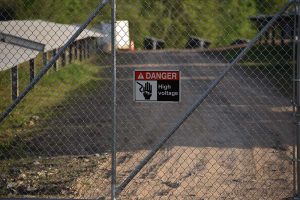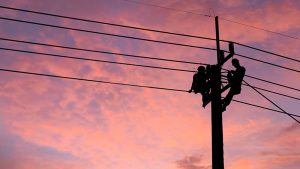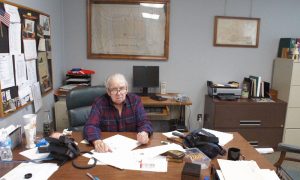Scores of projects remain in development around the state
By Ken Sturtz
Row after row of solar panels sat pointed toward the sky, their reflective surfaces gleaming in the sunlight as vehicles zipped by on a highway a hundred yards away, their drivers paying little attention to the array of panels.
It’s been more than half a decade since Oswego County inked a deal allowing a developer to build this 2-megawatt solar farm on 9 acres of county-owned land in Volney.
In exchange, the developer agreed to provide the county electricity at a discounted rate for 20 years. At the time the Volney farm was one of the first significant solar projects in the area.
Today it has company. Thousands of solar projects — completed and under development — have popped up across the state.
Solar power has experienced explosive growth in New York, driven by more affordable solar panels, government subsidies and an all-out effort by the state to transition from fossil fuels to renewable energy.
A decade ago the total capacity of installed solar projects across the entire state stood at just 100 megawatts, roughly the same as the combined generating capacity of the 10 hydroelectric plants located in Oswego County. By 2016, statewide solar capacity had soared to 958 megawatts.
In July, the state announced 3,000 megawatts of solar had been installed across the state, enough to power more than half a million homes. Total capacity has since risen to 3,144 megawatts.
That’s more than the three nuclear reactors in Oswego County. The James A. FitzPatrick Nuclear Power Plant and the two units at Nine Mile Point Nuclear Station produce a combined total of approximately 2,745 megawatts.
Initially most solar projects consisted of residential or small commercial installations (The state’s 3,144-megawatt solar capacity is spread out across 148,000 projects). But in recent years growth has been increasingly driven by bigger commercial solar projects with the potential to produce much larger quantities of electricity.
For example, the state lists more than 6,000 projects in its pipeline that are supported by the New York State Energy Research and Development Authority (NYSERDA). They’ll have a potential capacity of 2,729 megawatts. Nearly 90% of that capacity will come from just 446 larger commercial projects. The state is also supporting 73 even bigger utility-scale projects that are under development.
Central New York’s share of solar projects — 21.4 megawatts over 474 projects in Oswego County and 39.8 megawatts across 1,337 projects in Onondaga County — has been relatively modest, but that’s already beginning to change.
NYSERDA lists 12 large commercial projects in the pipeline in Oswego County with a combined output of 65 megawatts. In Onondaga County, 28 projects are listed as being in development. They have the potential to generate 162 megawatts. Most but not all solar projects in New York receive support from the state.
Rapid Growth
L. Michael Treadwell, executive director of Operation Oswego County, said the Oswego County Industrial Development Agency (IDA) has approved a dozen projects in the last two years.
“There wasn’t any significant solar activity at all until the last two and a half years,” he said. “But things are very active.”
The influx of developers seeking support for solar projects was such that last year the IDA passed a solar projects PILOT deviation policy, standardizing criteria for developers seeking assistance on solar farms.
The projects that have received assistance from the IDA include four in Richland and three in Sandy Creek, as well as one each in Volney, the town of Oswego, Hastings, Scriba and the city of Oswego. Treadwell said total investment by the project developers is nearing $60 million.
The rapid growth of solar in New York is due to several factors. Experts point to the declining price of solar panels and improvements in solar technology that have made panels more efficient. New York also has vast amounts of inexpensive land in rural areas suitable for large solar farms.

The single biggest driver though has been the state’s aggressive stance on fighting climate change and reducing carbon emissions. New York has spent billions of dollars in ramping up clean energy, including investing in large-scale renewable projects, efforts to reduce building emissions and clean transportation initiatives.
In 2011, the state launched NY-Sun, an initiative within NYSERDA. The $1.8 billion program was meant to advance the scale-up of solar and move New York toward a sustainable, self-sufficient solar industry. Since the program’s launch it’s provided more than $1 billion in incentives, leveraging $5.3 billion in private investment.
New York’s Climate Leadership and Community Protection Act, which was passed in 2019, calls for 70% of electricity to come from renewable sources by 2030 and 6,000 megawatts of solar by 2025. It also sets a goal of a zero-emission electricity sector by 2040 and economy-wide carbon neutrality.
With installed projects and projects under development, New York is on track to hit 95% of its 6,000-megawatt solar goal.
In September, Gov. Kathy Hochul called for the expansion of the NY-Sun program to reach an even more ambitious goal of at least 10,000 megawatts of distributed solar installed by 2030.
The state’s aggressive efforts to scale up solar initially ran into a problem. As many as three out of four New Yorkers can’t install solar panels on their roof or property, said Chris Carrick, program manager of Energy Management for the Central New York Regional Planning & Development Board. Some are renters without access to a roof. In other cases, the roof faces the wrong direction for solar or the homeowner can’t afford the steep upfront costs.
So, New York joined several other states and in 2015 began allowing community solar.
The idea of community solar is to increase access to solar for homeowners and renters who might not be in a position to install solar panels at their home. Customers subscribe to a community solar project — a solar farm that’s been built somewhere else — and receive a credit on their electric bill for the power produced by the solar panels. Energy is still delivered to the customer by their regular electric provider; the renewable energy produced by the solar farm is fed into the electric grid.
New York ranked first in the nation in community solar installations in 2020, with 549 megawatts installed, most of which was supported by NY-Sun incentives. The state’s pipeline of solar projects is made up of more than 90% community solar or more than 800 projects.
The emphasis on community solar projects — which typically range from 2-5 megawatts and can take up 10-30 acres — is a significant change, Carrick said.
A decade ago his office was involved in several solar initiatives that included outreach and education campaigns. They held workshops for the public and worked with installers in an effort to sign residents up for small residential solar projects. It was tough work. Carrick said the equipment was expensive and the number of people who signed up was limited. Those who went forward tended to be higher income professionals or retirees who were concerned about the environment, he explained. Community solar has helped solar power to spread beyond early adopters.
“Now today it’s more of a mass market,” Carrick said. “We’ve seen this evolution from small rooftop projects to now these larger and larger systems.”
State incentives and New York’s ultra-ambitious renewable energy goals have certainly driven the adoption of community solar, said Mike Francis, president of Omni Renewables, a company that connects subscribers with community solar projects. He said what makes it popular with the public, however, is the idea that it breaks down the traditional barriers associated with solar, such as property ownership and capital, and allows virtually anyone to have a part in solar.
“With community solar it’s really the democratization of solar,” Francis said. “If you pay a utility bill, you can participate.”
Francis said his company currently has a pipeline of more than 150 megawatts spread over 27 projects, including two in Richland. A significant chunk of those projects already has subscribers, but the company is continuing to sign up customers, he said.
Convincing consumers of the soundness of community solar, which is regulated by the Public Service Commission, was an issue at first, but has become less so as awareness has grown.
“In the beginning the public used to think it was too good to be true,” Francis said. “I think the public is starting to figure out community solar is the real deal and it’s not some scam.”
Connecting to the Electrical Grid
Despite the rapid growth of solar across the state, scores of projects remain in development and have yet to actually come to fruition.
Of the 12 large solar projects in Oswego County that have received IDA support, so far just one project, a 2-megawatt solar farm in Sandy Creek, is completed and operating. That project was approved in 2018; the others were approved in 2019, 2020 or earlier this year.
“It takes a while,” Treadwell said. “These projects seem like they’re trying to move really fast, but they end up being fairly slow in terms of the process.”
Developers have to find a site to build their solar farm and secure financing for the project. There are the applications for state and IDA support, as well as approvals from local planning boards. In some areas developers have also faced stiff resistance from residents who don’t want them to build a solar farm near them.
Community solar projects, which typically range from 2-5 megawatts, tend to be somewhat simpler to develop. Larger utility scale solar farms of 25 megawatts or more are treated like a new power plant and must go through a process overseen by the state, which is more grueling and can take years.
“There’s a question about how many of these projects will actually make it to the finish line,” Carrick said. “A lot of these projects die on the vine.”

The reasons a project fails vary. Sometimes there are issues securing funding or overcoming public resistance. One of the biggest sticking points, however, is connecting a solar farm to the electrical grid, Carrick said.
Solar farms generally need to be sited close to transmission lines or it can become expensive to tie into the grid. And with much of the country’s electric grids aging, developers sometimes need to pay for costly improvements to distribution lines or substations so they can handle the larger amounts of electricity.
“One often overlooked benefit is these developers are being asked to foot the bill to improve the utility infrastructure for the benefit of everybody,” Carrick said.
Finding a suitable site has become increasingly challenging as the number of solar projects has skyrocketed, Treadwell said. In Oswego County, the larger solar projects are spread out geographically, but in locations where they can be connected to the grid for distribution.
“There was a kind of a race to identify sites that would be doable because you just can’t grab 25-30 acres out of the blue and say I’m going to put a solar farm there,” Treadwell said. “The critical issue of locating a solar farm is siteing it whereby you can get the connection to the grid at a reasonable development cost.”
Even if some of the solar projects on the drawing board statewide don’t make it to completion, it doesn’t seem to be a deterrent for future projects. Carrick said that if anything the projects moving forward will be larger because many of the costs are the same regardless of the size of the solar farm.
Treadwell said the influx of developers looking to build solar farms in Oswego County slowed down a bit this year, but will likely continue at a steady clip going forward. He said as time goes on, many developers are learning to propose copies of solar projects that have already been successful somewhere else.
“We have been flooded with projects and companies coming back with a repeat of another project in another location,” Treadwell said. “And we’re still getting projects.”
Featured Image: A 2-megawatt solar farm sits on nine acres of county-owned land in Volney adjacent to the Oswego County Soil and Water Conservation District offices. A decade ago the county signed an agreement with a developer allowing them to use the land for the solar farm in exchange for the county receiving electricity at a discounted rate.




